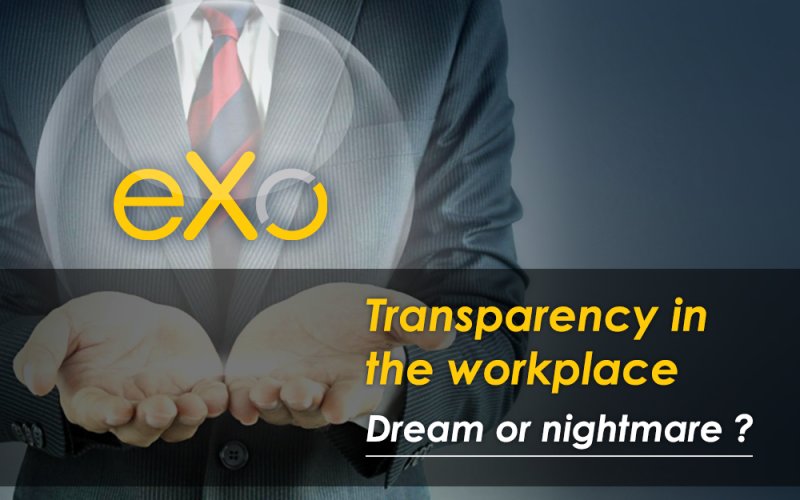- Veronika Mazour
- April 6, 2017
Transparency in the workplace – dream or nightmare?
Our culture increasingly values transparency in everything. Semantically, transparency is often associated with the truth and the lack of transparency with lying.
Freedom of speech and transparency go hand in hand with a democratic government. Recent scandals in the financial markets and the food industry have enhanced transparency in a company’s relationship with its customers. The birth of the internet and social media have helped to promote the wide expansion of information, opinions and ideas.

Content
Inevitably, transparency has become a much talked about and promoted value in the workplace and a constant mantra of the HR department.
1. What do we gain from transparency in the workplace?
First and foremost, transparency appeals to the young generation (the millennials and also the older X generation). In the current and upcoming shortage of talent in the work marketplace, a transparent workplace will help you to attract and retain talent.
Transparency boosts employee engagement, leading to a multitude of business benefits. Employees will develop a stronger sense of purpose if they can see the bigger picture and how their job fits within your company strategy.
Transparency in the workplace also drives efficiency. For example, employees can find information faster, they will receive answers to their questions more quickly and you can find innovative solutions faster through crowdsourcing.
Transparency in the workplace has a positive impact on your reputation. Since every employee and ex-employee represents you to the outside world, convincing your employees will help you to convince your customers.
2. What do we lose with transparency in the workplace?
Full transparency can have negative effects on individual performance.
Recently, a lot has been written on the negative effects of social media on our personal happiness levels, particularly because our friends’ lives always appear fuller and more colourful than our own. In the same way, knowing how much a colleague earns can be demotivating – especially if they make more than you for a poorer performance.
Transparency can be used to manipulate people’s opinions. Employees who are the most visible and ‘loud’ are not necessarily the most effective, but they often get a better deal.
An interesting study shows that contrary to what we might expect, transparency makes people more risk averse and more prudent because they are afraid of public judgement.
Making a decision or a workplace fully transparent exposes it to questions and comments from multiple people who are not necessarily experts on the subject and who often have divergent opinions. Trying to accommodate everyone and get public approval can be exhausting and counterproductive.
Too much information is stressful in itself, especially when the information is bad news. Not everyone is equipped or happy to share the stress of someone else’s job, especially when this job is CEO. When an employee is constantly exposed to worrying issues that they have no control over, they can become distracted from their main job. This will eventually harm their performance as well as the company’s.
The sheer amount of information shared in a transparent organisation can be overwhelming. In some organisations, employees complain about the ‘noise’, saying that they need to be connected all the time otherwise they cannot get anything done.
3. Three ways to promote transparency in the workplace without going overboard
- Get the right tools. If you want to move your company towards more transparency you will need to put in place an information-sharing tool with a social spin of some kind. You could try a social intranet, a knowledge-sharing platform, collaboration software, or a mixture of all of these.
- Display the right behaviour from the top down. Make sure your managers share losses as well as wins, explain their decisions, encourage transparent behaviour in their teams, praise risk taking and so on. Of course the ‘right behaviour’ in this context is the right behaviour for your organisation.
- Define rules that you feel comfortable with and discourage unwanted behaviour. You can protect the information that you want to keep secret, explain which opinions are welcome (subject, tone) and then discourage or publicly correct any unhealthy behaviour.
4. Become transparent and worry when you get there
If transparency is being widely discussed in your workplace, it is not yet being widely practised. Most companies start with a closed culture and have a hard time introducing any transparency. In that context, the benefits of transparency will largely offset any negatives mentioned above.
eXo Platform 6 Free Datasheet
Download the eXo Platform 6 Datasheet and
discover all the features and benefits
discover all the features and benefits
- Tags: Digital workplace, Tips & Tricks
4.5/5 - (11 votes)
I am the Chief Executive Officer of eXo Platform (the open source digital workplace platform), a company that I co-founded while in college and that I came back to after several years in the banking and consulting industry. I blog about modern work, about open-source and sovereignty issues. Occasionally, I also blog about my personal areas of interest, such as personal development, work–life balance, sustainability and gender equality.
Related posts
- All
- eXo
- Digital workplace
- Employee engagement
- Open source
- Future of work
- Internal communication
- Collaboration
- News
- intranet
- workplace
- Knowledge management
- Employee experience
- Employee productivity
- onboarding
- Employee recognition
- Change management
- Cartoon
- Digital transformation
- Infographic
- Remote work
- Industry trends
- Product News
- Thought leadership
- Tips & Tricks
- Tutorial
- Uncategorized
Leave a Reply
( Your e-mail address will not be published)



Insightful article Veronika. If I am to choose between allowing transparency in a company or not, I would vote allowing it. For me, transparency means that you trust your employees of the sensitive matters about the company and that you want them involved in it — this in turn creates sense of responsibility among employees and confidence that they can do something for the company. With regard to the negative effects of transparency, I think that depends on how your employees handle matters on their own personally and professionally.